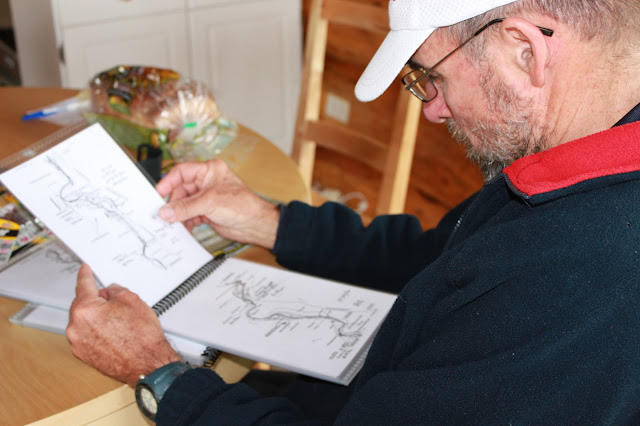"Yesterday, Sunday here, nothing open in town, spent the day
sorting out the gear and food for the race. Put target times on the maps. The
higher river means a fast race so I shortened the target times a little.
Frank had a full house yesterday with lots of tour groups
and a chinese film crew last night.
Very hot now, must be over degrees.
They had a late melt and now this hot weather has
accelerated the melt hence the high river levels.
Going to scagway today to pick up the boat and Urs and Arni.
I will try and open internet in town."
Love Tom
 |
| Tom is referring to Mike
Rourke's river maps and Topographical maps which he bought online from Mac's
Fireweed Books in Whitehorse From 2010 BLOG for the YUKON1000..... "What is critical racing on a river as fast as this is knowing where you are. Finding the fast water and the shortcuts. Paddle smart and you don't have to paddle hard. There are 110 maps, each map covers 15 to 20 kilometers. About an hours paddling. I am reducing them to A5 size, to make them manageable on my lap, putting them into sets and getting them laminated and bound, At some points in the river the river basin is 10 kilometers across, with 6 or 7 different channels and the best channel up to a kilometer wide. Taking the wrong channel will find us in very slow water. So I am clearly marking the way through with the fastest channel. Which is not necessarily the widest. I was able to use my times on the river in the three times I did the Yukon River Quest, at 760 kilometers that is less than half this race, but I have also used as a comparison the times of last years competitors, and in particular for the second half. So to navigate we will use both time distance down the river from known points, as well as way-points, Latitude and longitude. So I know where we should be time wise the whole race. Provided we can maintain those speeds. One critical time on the river is Lake Laberge. Lake Laberge is only about 2 hrs after the start, it is about 4 kilometers wide and 50 kilometers long. The other end of the lake is well and truly over the horizon and it can get very rough. As an idea this part of the race is equal to about two Twenty Beaches races or about the same length as the Molokai . If the wind is against you as it was for me in 2005 it can take 7 hours. In 2006 it was behind me and I surfed the lake for 4 hours with the GPS often clicking at 18 k/h. So that 3 hours difference may put my ETAs way out." Tom leaves Muktuk today to stay in town with Arnie and Urs. When he returns from Dawson after the race he will stay at Muktuk again for 2 days.
Christine
This German backpacker took a shine to Tom in 2010.
The main house at Muktuk.
Tom would be sleeping in the upstairs room at the back left, with a view of the river.
Sled dog training wheel for winter.
You can see why Tom and Frank are mates. Frank was until recently a competitor in the 1000 mile Yukon Quest dog race.
Still
having problems getting teams Spots up to speed. Besides the list of
people from whom I have yet to receive any messages, there are all those
teams from whom I have not received any messages in Whitehorse.
If you move any GPS a long way, it takes it a while to figure out where it is, and the Spots are low power devices and it takes them longer than most. I have seen them take 6 hours to work it out. Teams MUST set their devices to track and leave them on today and tomorrow. Then put in new batteries for the race. I want to see those tracks. You will not pass Tuesday's inspection without them.
|









No comments:
Post a Comment